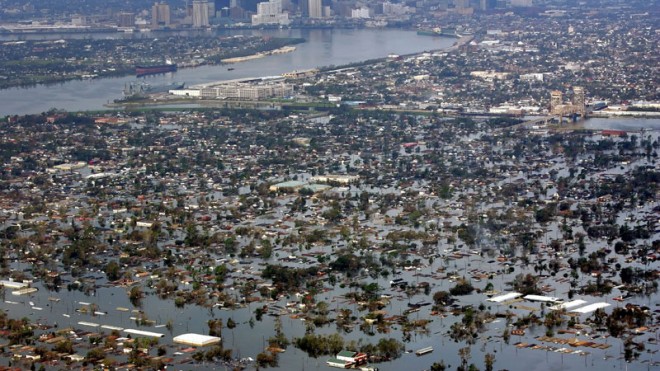
This Aug. 30, 2005 file photo shows floodwaters from Hurricane Katrina coverig a portion of New Orleans. A new psychology study shows that people are wrongly less prone to flee from hurricanes with feminine names. Yet the study finds female named storms have been deadlier in the United States than their macho sounding counterparts. Katrina and Sandy are the two deadliest storms to make landfall in the U.S. since names went co-ed in 1979. The study, which didn’t involve experts in meteorology or disaster science, is published Monday in the Proceedings of the National Academy of Sciences. (AP Photo/David J. Phillip, File)
WASHINGTON, DC — People are slightly less likely to flee an oncoming storm with a feminine name than a masculine one, a new study finds.
But hurricanes with feminine names turn out to be deadlier in the United States than their more macho-sounding counterparts, probably because their monikers make people underestimate their danger, the researchers conclude.
In fact, the two deadliest storms to make landfall in the U.S. since 1979, when male names were introduced, were named Katrina and Sandy.
The study, which didn’t involve any experts in meteorology or disaster science, is published Monday in the Proceedings of the National Academy of Sciences. Atlantic hurricane season started Sunday.
In six different experiments, more than 1,000 test subjects told behavioral scientists at the University of Illinois in Champaign that they were slightly more likely to evacuate from an oncoming storm named Christopher than Christina, Victor than Victoria, Alexander than Alexandra and Danny than Kate. They found female names less frightening.
“People are looking for meaning in any information that they receive,” said study co-author Sharon Shavitt, a professor of marketing. “The name of the storm is providing people with irrelevant information that they actually use.”
Shavitt said both men and women rated female storms less scary and they both “are likely to believe that women are milder and less aggressive.” It fits with other research about gender perception differences, she said. Sandy, while it can also be a male name, was chosen as a female name by weather authorities in 2012. Shavitt said it also ranked as rather feminine when she asked a small group of people to assess names on a masculine-feminine scale.
Hurricane and disaster science experts, such as Massachusetts Institute of Technology’s Kerry Emanuel, were skeptical at first. Then after more consideration some but not all found merit in the work, noting that it is more about psychology rather than physical science.
Emanuel said confusion over whether 2012’s Sandy was called a hurricane or post-tropical storm did cause confusion, so maybe names could make a difference too. He joked that maybe names matter and perhaps meteorologists should start using scarier-sounding ones like Jack-the-Ripper or King Kong.
But Susan Cutter, director of the University of South Carolina’s Hazards and Vulnerability Research Institute, dismissed the idea that female-named storms are deadlier. She considered the study results just coincidence.
To examine past death rates, Shavitt and doctoral student Kiju Jung used Shavitt’s scale that rated names from 1 to 11 in terms of masculinity and femininity. They looked at death rates going back to 1950 and found that, in general, the deadlier storms were more feminine.
However, male-named storms weren’t introduced until 1979. Only female names were used for storms from 1953 to 1978. From 1950 to 1952, military-style phonetic names (like Able, Baker, Charlie) were used and before that, there were no official names for storms.
While since 1979, female storms have been deadlier — even with the outlier of Katrina removed — the sample size is so small that the trend from 1979 is not statistically significant. But it is significant when combined with data from 1950, Shavitt said.
Also telling is that the amount of damages is not much different between male and female storms, indicating the big difference is not the size of the storm but how people react to it, Jung said.
This year’s hurricane names will be Arthur, Bertha, Cristobal, Dolly, Edouard, Fay, Gonzalo, Hanna, Isaias, Josephine, Kyle, Laura, Marco, Nana, Omar, Paulette, Rene, Sally, Teddy, Vicky and Wilfred.
Jung and Shavitt said one name jumps out at them for danger: Dolly. It’s considered highly feminine.